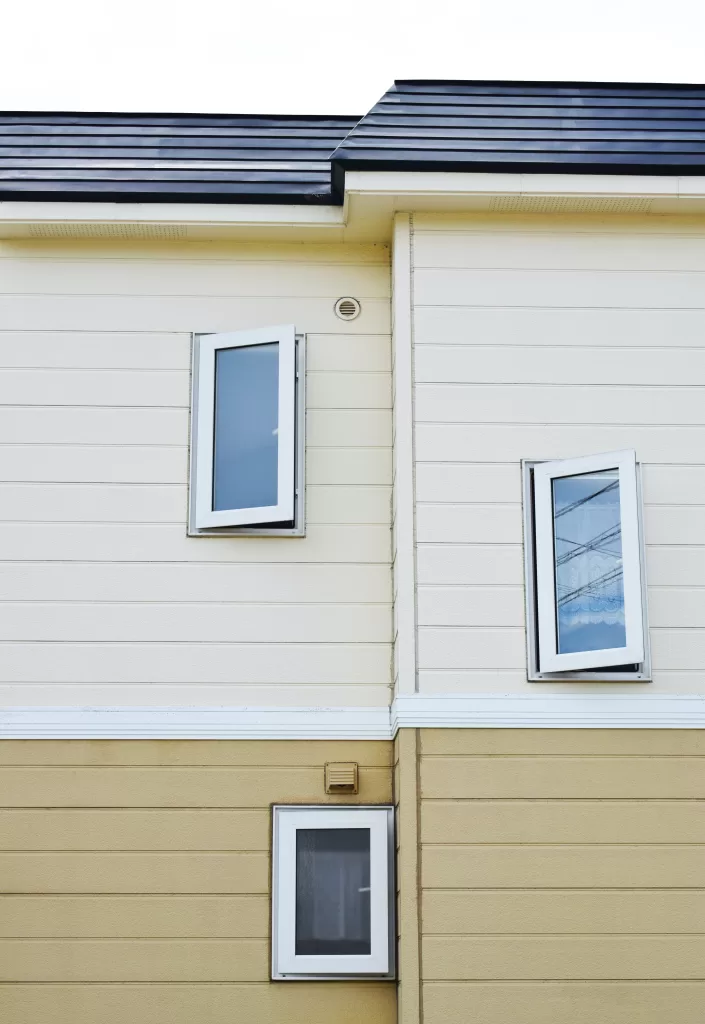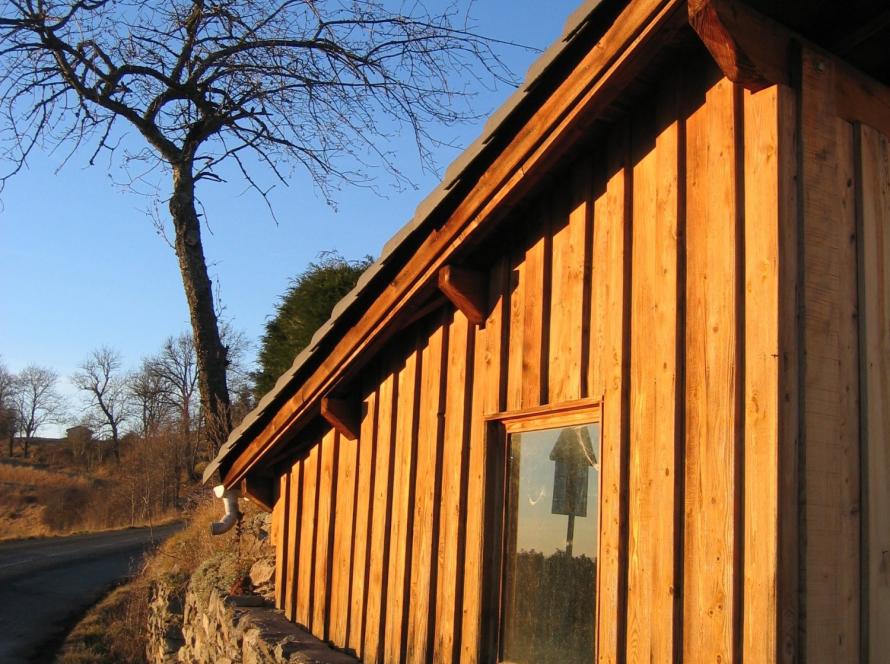Vinyl siding is your home’s second line of defense. It protects your walls from sun and water damage — two factors that can quickly damage your home’s interior.
Over time, vinyl siding will start to look pretty worn — even if you aren’t.
Can you paint vinyl siding?
The short answer is, “Yes!” But there are a few things to consider before you drag your painting supplies out of storage.
Here are some pro tips for tackling the project head-on.
What Are the Advantages of Painting Vinyl Siding?

Before you get too involved in a painting project, it’s wise to weigh out the pros and cons. Knowing what you’re up against can save you time and money.
Here are some of the advantages of DIY painting vinyl siding.
- Saves money
- Improves your home’s appearance
- Improves durability
- Increases your home’s value
And here are a few of the disadvantages you’ll need to think about:
- Potential to void your warranty
- You could damage the siding
- You could choose the wrong color
In the end, you may not get the results you’re looking for, especially if you’re hoping to extend the life of the siding.
We know you decided to buy vinyl siding, at least in part, because of its durability. While painting it may improve the way it looks today, you’re only applying a temporary fix if there’s underlying damage.
Before you paint, make sure to take note of any cracks or splits in the vinyl. Check for areas where the vinyl is warped or shows signs of buckling. These could indicate you need to replace rather than paint the vinyl.
Priming Before You Paint
Newer siding shouldn’t need a coat of primer. If you detect a chalky surface, you will want to consider applying primer.
So, what’s up with the chalk?
Since siding bears the brunt of the sun’s UV rays, it’s susceptible to what experts in the industry call vinyl siding oxidation. To see if it’s a problem on your siding, wet your finger and rub it across a dry portion of the siding.
If you see dusty white chalk on your finger, your siding is already going through oxidation.
Don’t panic if you notice oxidation. Instead, talk to a vinyl siding specialist and get their advice. In some cases, a primer may suffice, but there’s also the chance you’ll need to have the siding professionally cleaned before you paint.
Choosing the Best Paint
You’ve shopped for paint before. It’s fun because you get to grab a bunch of paint chips and spend a weekend seeing what the colors might look like on the wall.
Buying paint for siding isn’t quite like that.
First, you’re limited as far as color choices. Second, you can’t use just any paint on vinyl siding.
Unfortunately, using the wrong paint is a common mistake made by DIYers. And the biggest problem caused by choosing the wrong paint is that it won’t adhere.
It might take a day or even a week, but you’ll notice the paint bubble or start flaking off the vinyl surface.
The answer to this dilemma is to buy premium paint. Paint manufacturers offer homeowners several options.
To find a paint that works well on vinyl siding, you’ll need to read the paint can label. You’re looking for paint containing a blend of acrylic and urethane. You’ll find one at most big box home improvement stores.
Why Is the Right Paint Such a Big Deal?
Applying the wrong type of paint puts you at risk of cracking and peeling. Blame it on the weather.
Vinyl expands and contracts based on weather conditions. Some paints won’t expand with the vinyl, and once the paint starts peeling, you have a mess. You’ve wasted money and time.
You’re likely wondering if you need premium paint. Sure, premium on the label usually means you’ll pay a little more, but their excellent performance makes the more expensive paints worth it.
Most manufacturers also offer long-term warranties on premium paints. Why not take advantage of that, at least? Follow the instructions on the label, and you’ll enjoy the peace of mind a warranty offers.
Make Sure You Do the Prep Work
You prepped the walls the last time you painted a room inside your home. We hope so, but we also know some people are in such a hurry to see the new color they bypass the prep work.
You might get away with that on an interior wall, but you can’t avoid preparing your siding for new paint.
Considering the amount of dust and grime outside, it’s not a surprise that a lot of it ends up clinging to your siding. You probably won’t need much more than a garden hose with a nozzle if you’ve taken care of routine maintenance.
Tackling a grime buildup may require a soft brush or cloth and an appropriate cleaning solution. If you have a pressure washer, that will work well too.
On the initial cleaning, use only water. Afterward, look for moss, mold, and stubborn grime that you missed.
Consider using a cleaning solution formulated for vinyl siding if you need a second wash. You can also make a homemade cleaning solution. Try 70% water mixed with 30% white vinegar.
Rinse well. If you end up with cleaning solution residue, it can prevent the paint from adhering to the vinyl surface.
The last step of your prep work is to wait. It would be best to let the siding dry out for at least a day or two.
If you used a pressure washer, it’s possible water collected in the seams of your siding. Please let the siding dry completely before moving on to the next step—applying the paint.
Selecting the Best Paint Color
Earlier, we mentioned that selecting paint colors for vinyl siding isn’t as fun as picking out paint for interior walls.
Are you worried about choosing from a bland palette of paint colors? Please don’t lose any sleep over it because you’ll find plenty of colors formulated for painting vinyl siding.
Of course, you’ll hear all kinds of opinions. Some people will tell you there’s no way to change your current color completely. They’ll let you know it’s a big mistake to make a drastic change.
Many people are under the impression that the only colors available for vinyl siding are the standard whites and grays.
We have great news! If you’ve been dreaming of a siding transformation, you can change the color.
Many homeowners cover white vinyl siding with a serene blue or a rich shade of brick red.
Several years ago, we might have followed the advice to stick with the same color family. Thanks to modern paint technology, you don’t have to follow those rules as closely.
And as far as choices go, buying premium paint means you’ll benefit from the innovation of the paint suppliers who continue improving color choices. Today, you can select paint for vinyl siding from roughly 100 different colors.
You’ll have your choice of blues, grays, browns, yellows, and greens. And yes, if you love that brick red, why not go for it?
There is a caveat! We’ll talk about it next.
A Final Tip About Choosing Colors for Vinyl Siding
Even though paint manufacturers want to support your dreams of painting the house red, the type of vinyl siding you’ve installed may interfere. Here’s why:
Vinyl siding isn’t a one-size-fits-all product. It comes in different thicknesses. The thickness of a piece of siding determines how much heat it absorbs.
If you want one of the darker paint colors, be aware that dark colors absorb more heat than light paint colors. Choosing a color that absorbs more heat than your vinyl siding is designed to handle is possible.
Typically, premium paint manufacturers who offer paints formulated for vinyl siding recommend vinyl-safe colors—colors that won’t absorb too much heat. If you’re not sure whether you can move forward with the darker color you love, check with a vinyl siding contractor for help determining the thickness of your siding.
The primary reason for the concern over colors that absorb heat is that they may cause the siding to overheat, resulting in warping or cracking.
How to Paint Vinyl Siding
When you started talking about paint colors, you heard many opinions. You’ll also hear everyone’s statement about the best method to use when painting vinyl siding.
Even if you’re an expert painter, you’ll soon discover that painting vinyl isn’t like painting interior walls or wood siding.
First, when vinyl siding comes from the manufacturer, most of it has a low-gloss finish. But people also like the vinyl with a grainy pattern because it’s made to resemble wood.
Using a traditional brush and roller isn’t the best painting method. You’ll likely end up with brush and roller marks.
That’s why professionals use a paint sprayer! Spray painting is the ideal way to get a flawless finish.
When you use a paint sprayer, you avoid paint flaws, but it doesn’t take anywhere near as long as brushing or rolling. You will still need to prep the siding, which means prepping your home’s entire exterior.
You’ll need plastic sheeting to cover windows and doors. Don’t forget your gutters and downspouts. You’ll also need to cover bushes and hardscaping with tarps (if they sit close to the house).
If you’re not interested in buying one, you can rent a paint sprayer at most home improvement stores. Take time to get to know the machine. Also, use the correct size spray tip—you’ll find the tip size recommended by the manufacturer printed on the side of the paint can.
Weather matters too! We’ll cover that next.
When Can You Paint Vinyl Siding?
Most people won’t attempt to paint on a rainy day. We don’t advise it either. But what about painting in the hot sun?
If you can, avoid painting outside on a hot, sunny day. It might seem counterintuitive but bear with us a second.
Cool, overcast days are much better for painting outdoors. Paint adheres better to vinyl when it doesn’t have the sun beating down on it.
Direct sunlight prevents the paint from drying with a smooth finish. It can also increase the drying time for certain paints. And, if you plan to use two coats, you’ll need more drying time between coats on a sunny day.
Sometimes you can’t wait for perfect painting weather. If you paint on a sunny day, start on the shaded side of your home.
Remember that vinyl siding expands and contracts based on the weather. It tends to expand in warm weather and contracts in cold weather. So, in addition to waiting to paint when it’s not hot and humid, you’ll also want to avoid days that are too cold.
According to paint experts, a minimum temperature of 50° F is best for outdoor painting. You’ll also want to watch out for nighttime temps below 32° F for several days after you paint.
How Often Should You Paint Siding?
We’re all about saving money and time. After all, we’re homeowners too!
So, while painting vinyl siding yourself can save you some money, it’s only a short-term solution.
Expect the paint job to last around 2-5 years. The climate where you live can reduce that timeframe, especially if you live in an area where it’s humid. Heavy snows and lots of direct sunlight also impact the longevity of outdoor paint.
If you’re only trying to improve your home’s curb appeal and don’t plan to live there for several more years, go ahead and paint.
If this is your forever home unless you want to invest money and time every few years in a fresh coat of paint, replacing the vinyl siding may be your better option.
Let’s dive a little deeper into how to determine if painting is the best solution. You have several factors to consider.
Age and Condition Matter
You might be getting the idea that it isn’t only a question of can you paint vinyl siding, but it’s also if you should paint it.
Knowing the age of your current siding will help you decide. The newer the siding, the easier and more affordable it is to paint.
Depending on its age, you may need to replace your siding in a few years anyway. With proper maintenance, vinyl siding can last 20-40 years.
Older siding poses more of a challenge because it usually has at least a few dents and may also have other damage.
Before you decide to paint, you’ll want to perform a thorough inspection. Look for any of the following issues:
- Holes
- Cracks
- Mold
- Rot
- Deterioration
While you might be able to replace a few pieces of damaged siding, too many of these significant siding issues will prevent you from painting. Sure, a fresh coat of paint can hide some signs of aging, but it’s a temporary fix.
The problems underneath the paint won’t go away. For example, mold will keep growing, cracks get bigger, and rot and deterioration don’t stop just because they’re covered up with paint.
Eventually, you’ll need to invest in new siding.
Check Your Warranty
At the beginning of this article, we mentioned the warranty. Before you paint, read the current warranty (if it’s still valid).
Painting your siding while it’s still under warranty may void the warranty.
A current warranty could save you some money if you want to paint vinyl siding because it’s damaged. Generally, a siding warranty will cover the damages from the following:
- Weather damage
- Improper installation
If you know that you have a current warranty, call the contractor who installed it before you paint. They may be able to help figure things out.
Weight the Benefits of Painting vs. Replacing Vinyl Siding

Whether you paint it or replace it, you’ll invest some money. There’s a big difference in the financial investment when you paint vs. replace vinyl siding.
Replacing siding takes more time, and it costs more money. But wait a minute before you throw the idea of new siding away. It might cost more, but vinyl siding is still one of the most budget-friendly siding solutions available today.
Let’s say you’re looking at siding that’s near the end of its useful life. Maybe you or the previous owner didn’t pay much attention to maintenance.
Replacing the old vinyl siding means you have a long-term solution.
It’s like getting a fresh canvas and one that won’t require painting every 2-5 years, provided you take care of maintenance.
Speaking of maintenance, manufacturers today cover new vinyl siding with high-quality paint. It’s designed to resist fading, chipping, cracking, and bubbling—even under extreme weather conditions.
Maybe your current siding isn’t thick enough to absorb the heat. Or perhaps it isn’t insulated.
Replacing rather than painting offers you the option of upgrading. You’ll enjoy the benefits of siding manufactured with the latest technology, which can add even more longevity.
Are You Tempted to Replace Instead of Paint?
One more reason many homeowners decide to replace current siding rather than paint has to do with choices. Today, manufacturers offer more styles of vinyl siding finishes than ever, including:
- Smooth
- Wood Grain
- Clapboard
- Board & Batten
- Traditional Lap
- Dutch Lap
Even if you decide to move forward with painting your siding today, you’ll have an idea about what’s available in the near future when you’re ready to replace it.
Now back to our final words on painting vinyl siding.
Not Every Homeowner Enjoys Painting
After everything we’ve said about the ease of prepping the surfaces for paint, choosing the best paint and color, and renting a paint sprayer, get ready for a curveball.
You’re thinking about your options, and you’ve concluded that it’s time to paint. If you’re like many homeowners, you don’t relish the idea of spending an entire weekend (or longer) painting the outside of your house.
You’re not entirely confident that you can handle a paint sprayer. And you don’t look forward to climbing up a ladder either.
There’s no reason to feel guilty!
You can call a painting company to come out and get the job done for you. If the contractor that installed it doesn’t offer painting services, they’ll usually have a number for someone who does.
We also suggest calling a siding installer regardless because they can come out to your home and inspect your siding before you invest the time and money in painting.
Sometimes getting another eye on something helps uncover damage you didn’t notice before. A siding contractor can also better assess the condition of your siding. It might be older than you think or have heavier damage that requires repair before you can paint.
Getting a second opinion on whether you can paint your vinyl siding can save you money and time.
Need A Siding Professional to Help?

Compare Quotes from Top-rated Siding Contractors in your area.
So, Can you paint vinyl siding? Yes!
Whether you decide to look at it as a DIY project, hire a contractor, or determine you need work done under your warranty, a professional contractor can help.
Our local Siding Contractors are ready and able to answer your questions.




Facebook
Comments